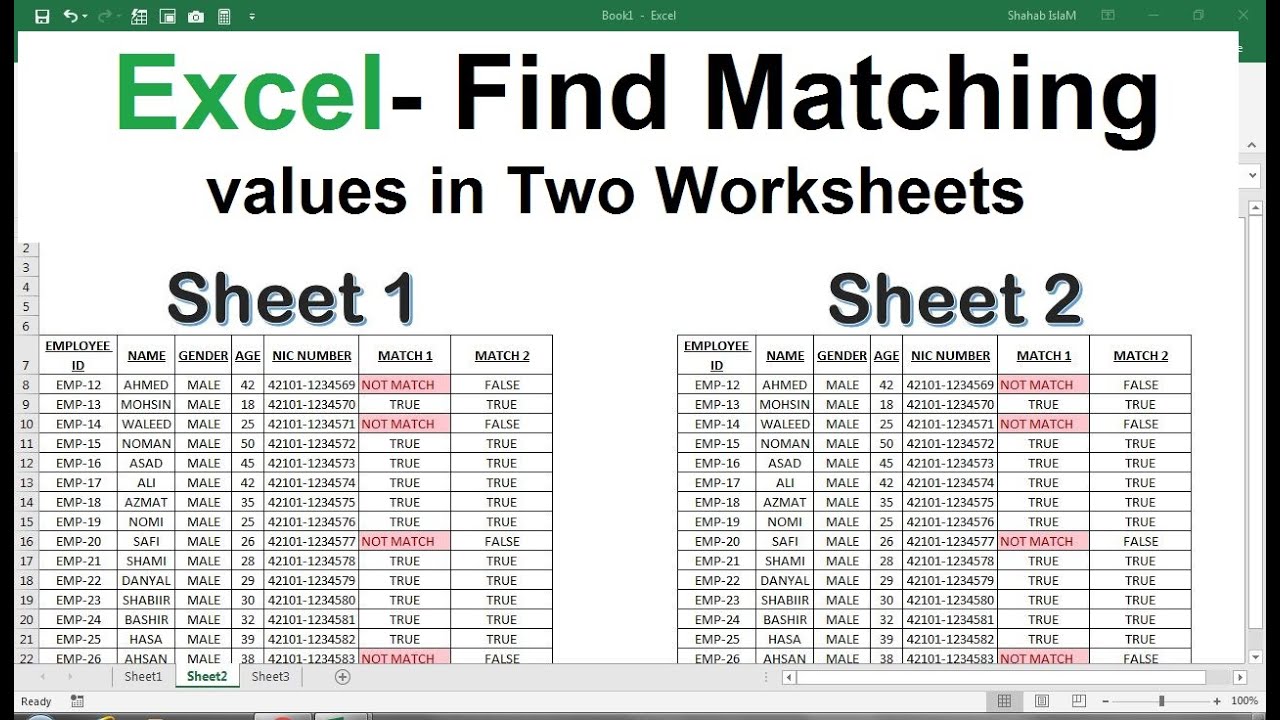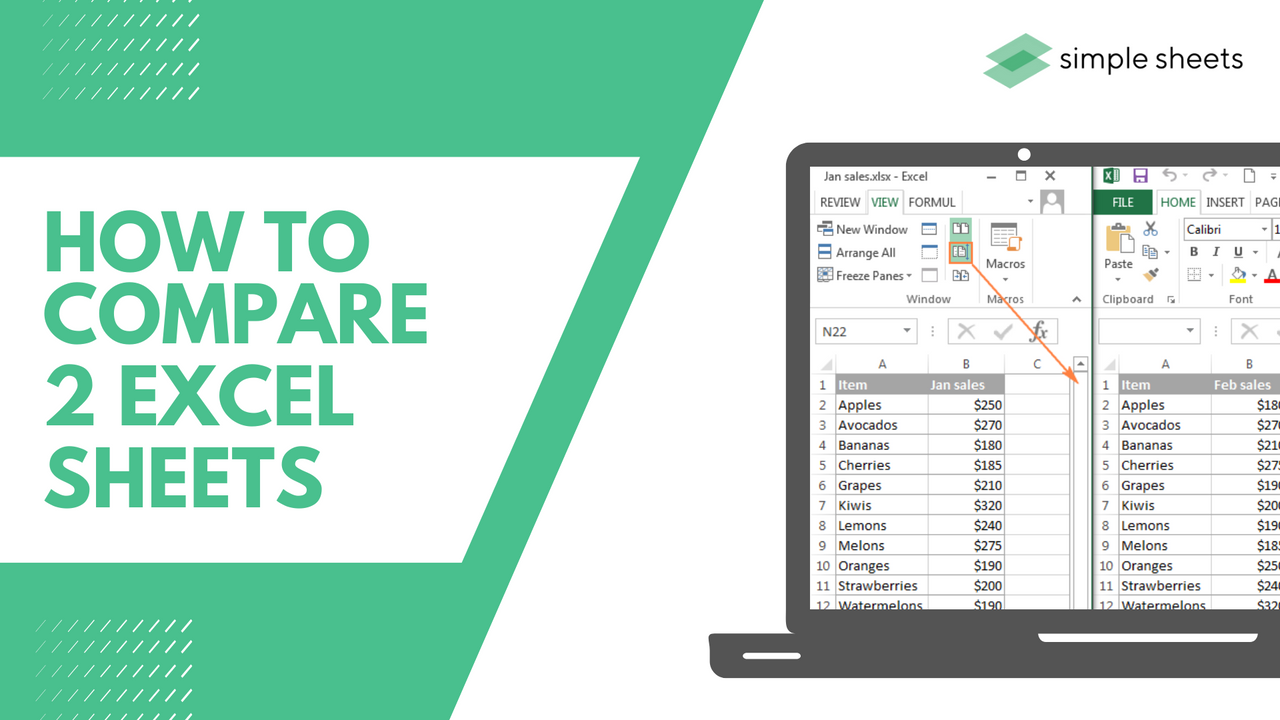5 Ways to Compare Excel Sheets for Matches

Comparing Excel sheets is a common task for many professionals and can be essential for tasks such as data validation, reconciliation, or simply understanding changes between different versions of a spreadsheet. Whether you're working on financial reports, managing databases, or just organizing personal information, knowing how to efficiently compare Excel sheets can save time and reduce errors. Here are five detailed methods to compare Excel sheets for matches:
1. Manual Comparison

The simplest, yet most time-consuming method, involves manually scrolling through each sheet to look for matches or differences:
- Open both Excel files or work with different tabs within the same file.
- Align the sheets by selecting ‘View Side by Side’ from the ‘View’ tab to see both at once.
- Check each cell or range manually for matches.
💡 Note: Manual comparison is prone to human error and is not recommended for large datasets.

2. Excel’s Inbuilt Conditional Formatting

Excel’s Conditional Formatting can highlight duplicates or differences:
- Select the range you wish to compare across both sheets.
- Go to ‘Home’ > ‘Conditional Formatting’ > ‘Highlight Cells Rules’ > ‘Duplicate Values’.
- Choose a format to highlight cells that match in both sheets.
📌 Note: This method is useful for visualizing matches and differences quickly.

3. Using Vlookup or Index Match

These functions allow for dynamic comparison:
- VLOOKUP - Looks up a value in the first column of a range and returns a value from the same row in a specified column.
- Index Match - More flexible than VLOOKUP, it can look up values in any column and return corresponding values from any row.
| Function | Usage | Description |
|---|---|---|
| VLOOKUP | =VLOOKUP(lookup_value, table_array, col_index_num, [range_lookup]) | Search for a value in the leftmost column of a table, then return a value from the same row in the specified column. |
| INDEX/MATCH | =INDEX(array, MATCH(lookup_value, lookup_array, 0)) | Index returns the value of a cell in a table, and Match searches for a value in a range. |

🌟 Note: These formulas are great for dynamic lookup but require some Excel proficiency.
4. Using Excel Add-Ins or Plugins

There are several third-party add-ins available that simplify the task of comparing sheets:
- Tools like ‘XL Comparator’ or ‘Ablebits.com Compare Sheets’ provide a user-friendly interface to compare.
- These tools often offer advanced options like highlighting differences, commenting on changes, and reporting functionalities.
5. Advanced Features and VBA

For large datasets or recurring comparisons, Visual Basic for Applications (VBA) scripts can automate the process:
- Write a VBA script to compare sheets or workbooks programmatically.
- Scripts can loop through ranges, highlight differences, or even generate reports of the differences found.
Sub CompareTwoSheets()
Dim ws1 As Worksheet, ws2 As Worksheet
Dim r1 As Range, r2 As Range
Dim cell1 As Range, cell2 As Range
Set ws1 = ThisWorkbook.Sheets(“Sheet1”)
Set ws2 = ThisWorkbook.Sheets(“Sheet2”)
For Each r1 In ws1.UsedRange
Set r2 = ws2.Range(r1.Address)
If r1.Value <> r2.Value Then
r1.Interior.Color = RGB(255, 0, 0)
r2.Interior.Color = RGB(255, 0, 0)
End If
Next r1
End Sub
🚀 Note: VBA requires some programming knowledge but offers the most flexibility in comparison.
To conclude, comparing Excel sheets can be approached through various methods, each suitable for different needs:
- Manual comparison is straightforward but impractical for large data sets.
- Conditional Formatting provides a visual cue for quick matches and differences.
- VLOOKUP or Index Match are useful for dynamic comparisons.
- Add-Ins or Plugins offer a user-friendly approach with added features.
- VBA scripting automates the process for regular or complex comparisons.
Choosing the right method depends on your level of comfort with Excel, the size of your dataset, and how often you need to perform these comparisons. By leveraging these techniques, you can streamline your data comparison tasks, increase efficiency, and ensure data integrity.
What is the easiest way to visually compare two Excel sheets?

+
The easiest way for a visual comparison is to use Excel’s ‘View Side by Side’ feature from the ‘View’ tab.
Can I highlight differences without using VBA?

+
Yes, Conditional Formatting can be used to highlight differences or matches without VBA.
Is there a way to compare sheets if their data structure differs?

+
With VBA or Excel add-ins, you can handle different data structures by defining comparison criteria based on unique identifiers or keys.
How can I compare data from different workbooks?

+
Excel’s inbuilt features like Conditional Formatting work across workbooks. Also, VLOOKUP and Index Match can be used by referencing external workbooks.
Are there performance issues when comparing large datasets?

+
Manual methods and conditional formatting can become slow with large data sets. VBA scripts or add-ins are more efficient for such scenarios.